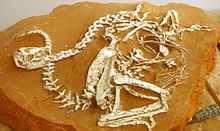Khaan
| Khaan | |
|---|---|

| |
| Holotype IGM 100/1127 | |
| Scientific classification | |
| Domain: | Eukaryota |
| Kingdom: | Animalia |
| Phylum: | Chordata |
| Clade: | Dinosauria |
| Clade: | Saurischia |
| Clade: | Theropoda |
| Family: | †Oviraptoridae |
| Subfamily: | † Heyuanninae
|
| Genus: | †Khaan Clark, Norell & Barsbold, 2001 |
| Species: | †K. mckennai
|
| Binomial name | |
| †Khaan mckennai Clark, Norell, & Barsbold, 2001
| |
Khaan (
Description

Khaan did not differ much from other oviraptorids. At first, its remains were assigned to "
The oviraptorid diet is disputed, with plants and molluscs having been suggested. Like other oviraptorids, Khaan was probably at least partially a meat eater, feeding on small vertebrates like mammals, lizards and possibly other small dinosaurs. It was also probably feathered.
Discovery
The
The holotype IGM 100/1127, consists of an almost complete skeleton found together with another specimen, IGM 100/1002. Together they were informally referred to as "Romeo and Juliet". These individuals are about four feet long. A third, considerably larger, specimen, IGM 100/973, was referred to the species.
Classification


Khaan was by Clark assigned to the Oviraptoridae. Among oviraptorids, it was probably more closely related to Conchoraptor.
The cladogram below follows an analysis by Fanti et al., 2012.[2]
| Oviraptoridae |
| |||||||||||||||||||||||||||||||||||||||
Paleobiology

According to a 2014 study published in
A 2022 study of the bite force of Khaan and comparisons with other oviraptorosaurs such as Incisivosaurus, Citipati, and Conchoraptor suggests that Khaan had a very strong bite force. The moderate jaw gape seen in oviraptorosaurs is indicative of herbivory in the majority of the group, but it is clear they were likely feeding on much tougher or more types of vegetation than other herbivorous theropods in their environment, such as ornithomimosaurs and therizinosaurs were able to. The examinations suggest oviraptorosaurs may have been powerful-biting generalists or specialists that partook of niche partitioning both in body size and cranial function.[4]
